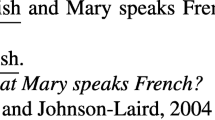Abstract
under uncertainty has revealed that people judge the probability of an event to be higher when the event is described as a disjunction of constituent events or when they judge constituent events separately. These observations have motivated the development of support theory (Y. Rottenstreich & A. Tversky, 1997; A. Tversky & D. J. Koehler, 1994), a descriptive model of judgment under uncertainty. The major predictions of support theory are that (1) the judged probabilities of complementary events sum to 1; (2) the judged probabilities of n > 2 exclusive and exhaustive events generally sum to more than 1; and (3) the judged probability of an event generally increases when it is described as a disjunction of specific possibilities. We test these predictions in 6 studies of experienced attorneys who judged the likelihood of particular trial outcomes or were asked to offer advice on whether or not to accept a settlement offer. The results demonstrate that attorneys are indeed susceptible to bias in forecasting trial outcomes, consistent with support theory.
Similar content being viewed by others
REFERENCES
Arkes, H. R. (1991). Costs and benefits of judgment errors: Implications for Debiasing. Psychological Bulletin, 110, 486–498.
Bearden, N.,Wallsten, T., & Fox, C. R. (2001). Constrasting stochastic and support theory explanations of subadditivity. Manuscript in preparation.
Birke, R., & Fox, C. R. (1999). Psychological principles in negotiating civil settlements. Harvard Negotiation Law Review, 4, 1–57.
Fischhoff, B., Slovic, P., & Lichtenstein, S. (1978). Fault trees: Sensitivity of estimated failure probabilities to problem representation. Journal of Experimental Psychology: HumanPerception and Performance, 4, 330–344.
Fox, C. R. (1999). Strength of evidence, judged probability, and choice under uncertainty. Cognitive Psychology, 38, 167–189.
Fox, C. R., Rogers, B. A., & Tversky, A. (1996). Options traders exhibit subadditive decision weights. Journal of Risk and Uncertainty, 13, 5–17.
Fox, C. R., & Tversky, A. (1998). A belief-based account of decision under uncertainty. Management Science, 44, 879–895.
Guthrie, C., Rachlinsky, J. J., & Wistrich, A. J. (2001). Inside the judicial mind. Cornell Law Review, 86, 777–830.
Kahneman, D., Slovic, P., & Tversky, A. (Eds.). (1982). Judgment under uncertainty: Heuristics and biases. Cambridge, England: Cambridge University Press.
Loewenstein, G., Isaacharoff, S., Camerer, C. F., & Babcock, L. (1993). Self-serving assesments of fairness and pretrial bargaining. Journal of Legal Studies, 22, 135–159.
Lord, C. G., Ross, L., & Lepper, M. R. (1979). Biased assimilation and attitude polarization: The effects of prior theories on subsequently considered evidence. Journal of Personality and Social Psychology, 37, 2098–2109.
Redelmeier, D., Koehler, D. J., Liberman, V., & Tversky, A. (1995). Probability judgment in medicine: Discounting unspecified possibilities. Medical Decision Making, 15, 227–230.
Rottenstreich, Y., & Tversky, A. (1997). Unpacking, repacking, and anchoring: Advances in support theory. Psychological Review, 104, 406–415.
Taylor, S. E., & Brown, J. D. (1988). Illusion and well-being: A social psychological perspective on mental health. Psychological Bulletin, 103, 193–210.
Teigen, K. H. (1974). Subjective sampling distributions and the additivity of estimates. Scandinavian Journal of Psychology, 24, 97–105.
Tversky, A., & Kahneman, D. (1983). Extensional vs. intuitive reasoning: The conjunction fallacy in probability judgment. Psychological Review, 91, 293–315.
Tversky, A., & Koehler, D. J. (1994). Support theory: A nonextensional representation of subjective probability. Psychological Review, 101, 547–567.
Author information
Authors and Affiliations
About this article
Cite this article
Fox, C.R., Birke, R. Forecasting Trial Outcomes: Lawyers Assign Higher Probability to Possibilities That Are Described in Greater Detail. Law Hum Behav 26, 159–173 (2002). https://doi.org/10.1023/A:1014687809032
Issue Date:
DOI: https://doi.org/10.1023/A:1014687809032




